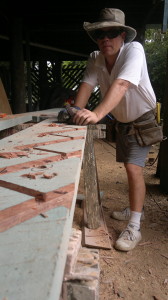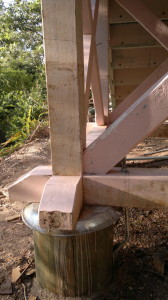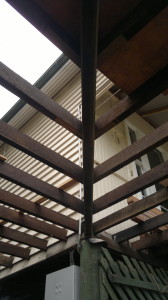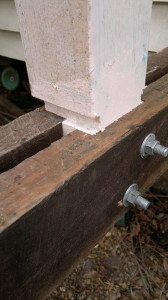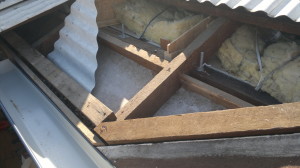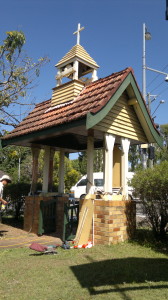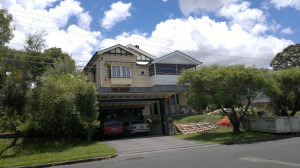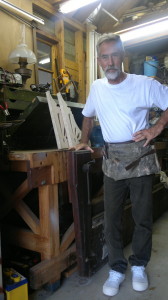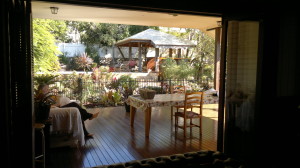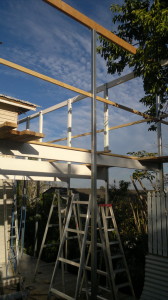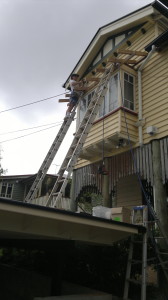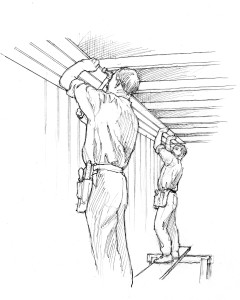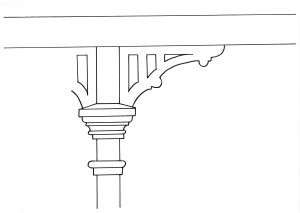We have been restoring and enlarging heritage houses in Brisbane since 1975, and are sticklers for quality and historic accuracy.
Our aim, given owner’s support, is to leave no sign of recent interference on a fine old house; not always possible given the necessities of modern living, but that aim must certainly apply to roof-lines, joinery, cladding, etc., and all internal mouldings for VJ or BJ partitions, belt-rails, skirtings and scotias.
From stumps to ridge-capping we have expert knowledge and construction techniques, supplying plans for council and advice for owners. We are hands-on carpenters and builders, working with fellow-tradesmen to complete a project, building stairs, steps, balustrades, kitchens, bathrooms as required, with particular attention to the character of the existing home.
Please refer to the second edition of ‘The Building of the Queensland House’ for useful advice regarding this type of work.
For information, contact me, Andy, at andrewljenner@gmail.com or Rupert, at jennerrupert@hotmail.com
Photos from a recent job follow……….some serious carpentry on Queenslanders:
For an external set of steps to a one-off design, with a particular going and rise, using massive iron-bark, it takes very little extra time and expense to work on-site, where the measurements are!
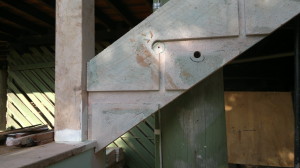
Finished stringer in position on landing, rot-treated, painted, and showing rebates for treads and risers, and hole for 18mm step-bolt.
All external timber is coated with copper napthenate and oil-primed, including all cuts, rebates and joints, prior to assembly. Unfortunately, using lead paint in joints and housings is illegal, though the best protector of timber. Copper is next best available.
Using a traditional technique to build the landing is pretty, and very strong, and the new CCA-treated stumps are foolproof.
There is a trick to making external steps with risers: the treads have a slope of 2mm down from front to back, for security of use, and a 5mm gap between the back of the tread and the riser to drain off rainwater. Seldom seen but necessary.
Balustrades are built as separate units; the ends of the rails slot into rectangular hardwood pegs set into the posts. There are no nails, screws or bolts into the posts, a regular cause of rot. With a bit of effort and a lever-bar, a section of balustrade may thus be removed to hoist in a grand piano.
All deck framing is CCA treated, and joints with copper napthenate. Trip-L-grips, where not seen, are an irreplaceable fix, though not kosher, and oversize sections take out the bounce. A veranda must be safe and secure.
Edge-boards, painted with the balustrades, take the weather well, unlike the projecting end grain of the decking, which deteriorates very quickly. The edge-boards slot neatly into the rebates in the posts, covering the top of the fascia, and sheltering all susceptible timber from sun and rain.
Well, not quite finished: the brackets and capitals for the posts have yet to be chosen. The purlins, in the old style, are checked-in flush with the tops of the rafters and hip, which have a broad section taken off the lower arris. This construction was designed by the owners to be seen, not covered. If you look carefully, the near-left post and section of un-painted head are all that is remaining of the original small veranda, for forensic sake: absolutely every other part is new.
Warning: Over the years we notice relatively new external carpentry has rotted to a horrifying extent, causing great worry and cost to owners. Why this is so is due to a few causes. From the time of building, a Queensland house would survive at least 50 years without damage, why not now? 1) Inferior timber (sapwood, ‘treated’ pine, blackbutt, etc) used 2) No permanent rot-proofing used in joints (lead or arsenic-based oil paint) 3) Water-based paint applied at any stage to external timber No.3 is the worst offender, despite advice to the contrary from painters. 100-year-old cladding exposed to the elements will start decaying from the day it is coated with plastic paint; moisture that has penetrated can not dry out, causing fungal attack. Take note, painters. Oil-based paint or no paint is the rule. Yes, modern plastic paints are excellent, and superior, but never on exposed timber. What is the point of installing expensive external carpentry and joinery if it is to be ruined by the misguided application of plastic paint?
Here are some more work-photos of jobs both heritage and contemporary around Brisbane, thanks to considerate owners who want the best in building practice for their beautiful Queensland houses. Andy and Rupert have constructed all the new carpentry and building that follows……….
Building the gazebo was fun, using very large sections of cypress pine for all construction; cypress is a rather neglected timber, however, it is harvested from our native self-generating forests, and has many excellent properties: it is virtually rot- and termite-proof, resisting all weathering-decay. It needs no painting or preserving with poisons, and has the most beautiful smell. We try to use it for all exposed situations where finish and strength are a secondary consideration, but it will outlast all other timbers.
The frame for the external part of the deck is all Queensland cypress, from Womble Bank.
An hour with the welder is worth two day’s carpentry; there’s the rub. It ain’t pretty but it’s quick and strong.
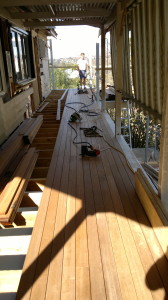
Rupert fixing a gun-barrel deck; notice the new posts, joists and edge-board, rescuing a previous disaster.
We rely on the other trades in our projects; many are now old friends with invaluable knowledge and reliability. Our trust in their work makes life easy
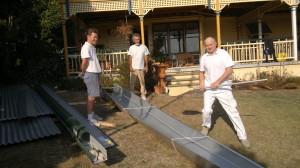
Pondering the lifting of an unwieldy length of flashing; we fix all our corro, but draw the line at roof-tiles and slate. Rupert, Andy, and Kevin.
Here are some illustrations from the second edition of ‘The Building of the Queensland House’, available from many independent bookshops. Google the title for details. John Braben is the artist; his drawings show carpenters at work on Queenslanders over 100 years ago, when the carpentry trade was a real craft, a craft Rupert and I continue to this day.
John has a list of artistic credits as long as your arm, and in ‘The Building of the Queensland House’ he has many more fine drawings of early Brisbane carpentry, including the landscape of Red Hill which wraps the cover.
25th June 2014 Rupert and I have decided to do a letter-box drop locally, targetting those beautiful old Queensland houses that are missing all the intricate veranda detail that makes them so attractive; this is what we’re saying…………
There are so many beautifully preserved old Queenslanders on our streets, except, that is, for the finishing of the veranda. I don’t know why this is so. Can the owners a) not want it, b) not afford it, c) not realise it is missing, or d) not care?
When the house next door is immaculate in its historic finery, it is hard to believe the lack is deliberate. Anyway, we have been gently pointing out in our unsolicited junk trash mail that the staggeringly fine houses in question are missing their vital post brackets and capitals, the replacement of which would increase the value a thousandfold, and be the envy of the neighbourhood……….to no avail so far, but we’re hoping for a job or two for the effort.
Seriously, once the veranda decorations are applied, it does make a huge difference to the aspect of the facade. There are many styles of many eras to choose from; it would be a mistake to put 1890 brackets on a 1930 house, for example, but the original builders would never have left off those details.
We are particular about all replacement carpentry and joinery in heritage houses. There are important points to be aware of, even with a simple fixture like a post bracket….. 1) Brackets must be cut ‘on the bias’, the grain running diagonally. 2) The finished piece must be treated all round with CCA or copper napthenate. 3) Oil primers and paints only must be used. 4) The brackets should be painted the same (light) colour as the posts and the capital mouldings.
We have good reasons for all the above, even no. 4. Brackets are often seen painted a dark colour, even charcoal-grey. May as well not have them, being invisible. The post fixtures represent a form of classic column, being an intrinsic part of the post, and must therefore be painted as one. You wouldn’t paint the spokes of a wheel in different colours.
Many of these brackets were popular in different periods. The two similar patterns on the left of the top and middle rows were common over a 40-year span. As fashions changed, styles became more simple until, in the 1940s these brackets were replaced by very plain curved or angular sweeps across the veranda-head from post to post.
As a footnote, and supporting other blogs concerning the Queensland house, it must be apparent that the state has been losing its heritage constantly over the last forty-odd years as zoning regulations literally clear the way for multiple-dwelling development.
Whole inner-suburb blocks in Brisbane now have but a few of the original houses, and I use the word ‘original’ explicitly, because, in every case, the houses being demolished were and are the very first to be built on their sites. Historic documents show open paddocks and bush where no previous architecture has ever existed.
The Queensland house was a pioneering project, and is now part of our history. Local planning treats this invaluable heritage as ‘slum-clearance’ with the crass bravado of third-world gluttony for the New. The only safeguard for our indigenous domestic houses lies with the householders themselves.
It is essential, if our towns and cities wish to retain any last semblance of the historic credentials of the pioneer settlers, that the fortunate present owners recognise the treasure they possess. Each stump, each vee-joint board, each piece of hoop-pine or spotty-gum tongue-and-groove flooring, was cut from the surrounding scrub, processed in a bush sawmill and machine shop, and assembled by expert carpenters who were themselves New Chums. To treat these houses with disrespect is a crime and an insult to the battlers who created our communities.

